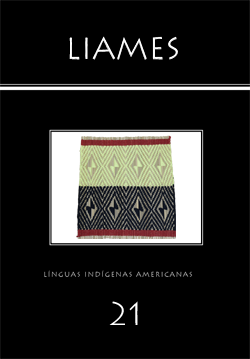Abstract
A cleft sentence (cf. Lambrecht 2001; Hartmann and Veenstra 2013) is a specific syntactic pattern which serves to separate a discourse prominent constituent structurally from the rest of the clause. It’s a complex sentence that expresses a single semantic proposition and is one of the main focus marking devices in the world's languages.
By observing how morphosyntax encodes pragmatic meanings, the purpose of this article is to study cleft sentences in Toba language (or Qom lʔaqtaqa, Guaycuruan family) within the framework of Information Structure (Lambrecht 1994).
The discussion on clefts sentences in Toba/Qom includes a characterization of their morphosyntax, and a delimitation of their pragmatic meaning, based on a corpus that consists of elicited utterances as well as spontaneous interactions.
In terms of their function, cleft structures in Toba/Qom allow speakers to specify or correct expectations, showing a narrow focus structure, and are compatible with contexts of contrast and exhaustiveness.
The article contributes to the study of the syntax-pragmatic interface in this indigenous language and to provide empirical data for the definition of clefts in the languages of the world.
References
Califa, Martín; Belloro, Valeria (2020). Motivaciones discursivas para la posición de sujeto intransitivo en mocoví y toba (guaycurúes, Argentina). Lingüística 36(1): 103-125.
https://www.mundoalfal.org/ojs/index.php/Revista/article/view/46/41
Caron, Bernard (2016). Cleft sentences and beyond: Identification, specification, and clause structures in Zaar: Sans ‘it’, sans ‘COP’, sans ‘REL’, sans everything. HAL archives-ouvertes, ID: hal-01370125.
https://hal.archives-ouvertes.fr/hal-01370125.
Carpio, María Belén; Censabella, Marisa (2012). Clauses as noun modifiers in Toba (Guaycuruan). In Bernard Comrie; Zarina Estrada-Fernández (eds.), Relative Clauses in the Languages of the Americas. A typological overview, pp. 173-189. Amsterdam: John Benjamins. https://doi.org/10.1075/tsl.102.08car
Cúneo, Paola (2015). De la existencia al foco. Polifuncionalidad de las construcciones existenciales con woʔo en toba (guaycurú). In Zarina Estrada Fernández; Ana Fernández Garay; Albert Álvarez González (coord.), Estudios de lenguas amerindias 3. Escenarios de diversidad lingüística, pp. 285-311. Hermosillo, Sonora: Unison.
Cúneo, Paola (2016). Expresión de foco en toba (guaycurú). Una aproximación al interjuego entre sintaxis y estructura de la información. Cuadernos de la ALFAL, Revista de la Asociación de Lingüística y Filología de América Latina 9: 64-79.
http://www.mundoalfal.org/sites/default/files/revista/09_cuaderno_005.pdf
Cúneo, Paola; Messineo, Cristina (2019). Orden de palabras, posición del objeto y estructura de la información en toba/qom (Guaycurú). In Valeria A. Belloro (ed.), Estudios de Interfaz Sintaxis-Pragmática en español y lenguas de América, pp. 41-66. Berlín/ Boston: De Gruyter. https://doi.org/10.1515/9783110605679-003
Dik, Simon; Hofmann, Maria E.; de Jong, Jan R.; Sie Ing Djiang; Stroomer, Harry; de Vries, Lourens (1981). On the typology of focus phenomena. In Teun Hoekstra; Harry van der Hulst; Michael Moortgat (eds.), Perspectives on functional grammar, pp. 41-74. Dordrect, Holland: Foris. https://doi.org/10.1515/9783112329603-005
Drubig, Hans Bernhard (2003). Toward a typology of focus and focus constructions. Linguistics 41(1): 1-50. https://doi.org/10.1515/ling.2003.003
Drubig, Hans Bernhard; Schaffar, Wolfram (2001). Focus constructions. In Martin Haspelmath (ed.), Language typology and language universals: An international handbook, vol. II, pp. 1079-1104. Berlín/ Boston: De Gruyter.
Givón, T. (2001). Syntax: An introduction, vol. II. Amsterdam: John Benjamins. https://doi.org/10.1075/z.syn2
Gundel, Jeanette K. (2008). Contrasting perspectives on cleft sentences. In María de los Ángeles Gómez-González; J. Lachlan Mackenzie; Elsa González Álvarez (eds.), Languages and cultures in contrast and comparison, pp. 69-87. Amsterdam: Pays-Bas. https://doi.org/10.1075/pbns.175.06gun
Gundel, Jeanette K.; Fretheim, Thorstein (2002). Information structure. In Jef Verschueren; Jan-Ola Östman; Jan Blommaert; Chris Bulcaen (eds.). Handbook of pragmatics, pp. 1-17. Amsterdam: John Benjamins. https://doi.org/10.1075/hop.8.inf1
Hartmann, Katharina; Veenstra, Tonjes (eds.) (2013). Cleft structures. Amsterdam: John Benjamins. https://doi.org/10.1075/la.208
Keenan, Edward; Comrie, Bernard (1977). Noun phrase accessibility and universal grammar. Linguistic Inquiry 8: 63-99. http://www.jstor.org/stable/4177973
Krifka, Manfred (2008). Basic notions of information structure. Acta Linguistica Hungarica 55(3): 243-276. https://doi.org/10.1556/aling.55.2008.3-4.2
Lambrecht, Knud (1994). Information structure and sentence form: Topic, focus, and the mental representations of discourse referents. Cambridge: Cambridge University Press. https://doi.org/10.1017/CBO9780511620607
Lambrecht, Knud (2001). A framework for the analysis of cleft constructions. Linguistics 39(3): 463-516. https://doi.org/10.1515/ling.2001.021
Messineo, Cristina (2003). Lengua toba (guaycurú). Aspectos gramaticales y discursivos. (Lincom Studies in Native American Linguistics 48). Münich: Lincom Europa.
Messineo, Cristina (2006). ‘No hay’, ‘no puede’, ‘no (deb)es’. Estrategias de la negación en toba (guaycurú). RASAL. Revista de la Sociedad Argentina de Lingüística 2: 7-26.
Messineo, Cristina (2019). Syntactic complexity and Grammaticalization in Toba language. In Albert Álvarez González; Zarina Estrada-Fernández; Claudine Chamoreau (eds.), Diverses scenarios of syntactic complexity, pp. 191-216. Amsterdam: John Benjamins. https://doi.org/10.1075/tsl.126.08mes
Messineo, Cristina; Porta, Andrés (2009). Cláusulas relativas en toba (guaycurú). International Journal of American Linguistics 75(1): 49-68. https://doi.org/10.1086/598206
Messineo, Cristina; Renato, Alejandro (2013). La dimensión prosódica de la complejidad sintáctica. Un examen de la integración de predicados de complemento en toba. Ponencia presentada en el III Encuentro de Lenguas Indígenas Americanas (ELIA III), Bariloche, mayo 15-17.
Payne, Thomas (1997). Pragmatically marked structures. In Describing morphosyntax, pp. 261-305. Cambridge: Cambridge University Press. https://doi.org/10.1017/CBO9780511805066
Rosemberg, Celia; Alam, Florencia; Stein, Alejandra; Migdalek, Maia; Menti, Alejandra; Ojea, Gladys (2015-2016). El entorno lingüístico de niños pequeños argentinos/ Language environments of young Argentinean Children. CONICET. doi in progress.
Shibatani, Masayoshi (2019). What is nominalization? Towards the theoretical foundations of nominalization. In Roberto Zariquiey; Masayoshi Shibatani; David W. Fleck (eds.),. Nominalization in languages of the Americas, pp. 15-167. Amsterdam: John Benjamins. https://doi.org/10.1075/tsl.124.02shi
Skopetas, Stavros; Fiedler, Ines; Hellmuth, Sam; Schwarz, Anne; Stoel, Ruben; Fanselow, Gisbert; Féry, Caroline; Krifka, Manfred (2006). Questionnaire on information structure (QUIS). Reference manual. Interdisciplinary studies on information structure 4. Universidad de Postdam.
Ward, Gregory; Birner, Betty (2004). Information Structure and Non-Canonical Syntax. In Laurence Horn; Gregory Ward (eds.). The handbook of pragmatics, pp. 153-174. Oxford: Blackwell. https://doi.org/10.1017/S0008413100003947

This work is licensed under a Creative Commons Attribution-NonCommercial 4.0 International License.
Copyright (c) 2021 Paola Cúneo


